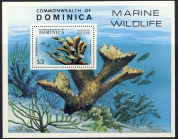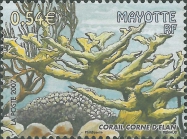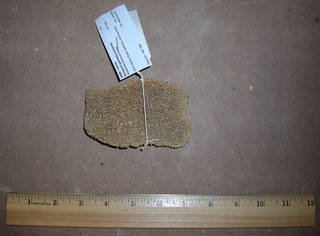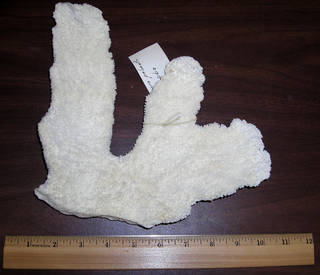Traits taxon details
Acropora palmata (Lamarck, 1816)
288227 (urn:lsid:marinespecies.org:taxname:288227)
accepted
Species
marine, fresh, terrestrial
(of ) Lamarck, [J.-B. M.] de. (1818). <i>Histoire naturelle des animaux sans vertèbres</i>. Tome cinquième, 612 pp. Paris, Deterville/Verdière. , available online at http://biodiversitylibrary.org/page/12886879 [details]
Hoeksema, B. W.; Cairns, S. (2024). World List of Scleractinia. Acropora palmata (Lamarck, 1816). Accessed through: Marine Species Traits editorial board (2024) Marine Species Traits at: https://marinespecies.org/traits./aphia.php?p=taxdetails&id=288227 on 2025-04-19
Marine Species Traits editorial board (2025). Marine Species Traits. Acropora palmata (Lamarck, 1816). Accessed at: https://www.marinespecies.org/traits/aphia.php?p=taxdetails&id=288227 on 2025-04-19
Date
action
by
original description
(of ) Lamarck, [J.-B. M.] de. (1818). <i>Histoire naturelle des animaux sans vertèbres</i>. Tome cinquième, 612 pp. Paris, Deterville/Verdière. , available online at http://biodiversitylibrary.org/page/12886879 [details]
context source (Hexacorallia) Fautin, Daphne G. (2013). Hexacorallians of the World. (look up in IMIS) [details]
basis of record Cairns, S.D., B.W. Hoeksema & J. van der Land. (2007). as a contribution to UNESCO-IOC Register of Marine Organisms. (look up in IMIS) [details]
additional source Cairns, S.D., W.C. Jaap & J.C. Lang. (2009). Scleractinia (Cnidaria) of the Gulf of Mexico. <em>In: Felder DL. Camp DK (eds.) Gulf of Mexico–Origins, Waters, and Biota. Biodiversity. Texas A&M Press, College Station, Texas.</em> Pp. 333–347. [details] Available for editors
additional source Veron JEN. (2000). Corals of the World. Vol. 1–3. <em>Australian Institute of Marine Science and CRR, Queensland, Australia.</em> [details]
additional source Wallace CC, Done BJ, Muir PR (2012) Revision and catalogue of worldwide staghorn corals Acropora and Isopora (Scleractinia: Acroporidae) in the Museum of Tropical Queensland. Memoirs of the Queensland Museum – Nature 57: 1-255. [details]
additional source Zlatarski VN, Martinez Estalella N. (1982). Les Scléractiniaires de Cuba avec des données sur les organismes associés. <em>Editions l'Académie bulgare des Sciences, Sofia.</em> 472 pp. [details]
additional source Grajales V.A., Aguilar C., Sánchez J. (2007). Phylogenetic reconstruction using secondary structures of Internal Transcribed Spacer 2 (ITS2, rDNA): finding the molecular and morphological gap in Caribbean gorgonian corals. <em>BMC Evolutionary Biology 7: 90.</em>
page(s): 6 [details]
additional source Kitahara, M.V., J. Stolarski, S.D. Cairns, F. Benzoni, J.L. Stake & D.J. Miller. (2012). The first modern solitary Agariciidae (Anthozoa, Scleractinia) revealed by molecular and microstructural analysis. <em>Invertebrate Systematics.</em> 26 (3): 303-315., available online at https://doi.org/10.1071/is11053
page(s): 305, 307 [details] Available for editors
additional source Cortès, J., Guzmán, H. (1985). Organismos de los arrecifes coralinos de Costa Rica III. Descripcion y distribucion geografica de corales escleractinios (Cnidaria: Anthozoa: Scleractinia) de la Costa Caribe. <em>Brenesia.</em> 24: 63-123. [details]
additional source Reyes J, Santodomingo N, Flórez P. (2010). Corales Escleractinios de Colombia. <em>Instituto de Investigaciones Marinas y Costeras (INVEMAR), Santa Marta, Colombia.</em> pp 1-246. [details]
additional source Veron, J. E. N. (2000). Corals of the World, Volume I: Family Acroporidae. Australian Institute of Marine Science. Townsville., volume 1, pp. 463.
page(s): 202-203 [details]
additional source Fautin, D. G.; Bucklin, A. (1988). Anthozoan dominated benthic environments. volume 3, pp. 231-236
page(s): 234 [details]
additional source Zlatarski, V. N.; Estalella, N. M. (1980). Scleractinia of Cuba with data on the constituent organisms [in Bulgarian]. Bulgarian Academy of Science. Sophia., pp. 312.
page(s): 17, 26, 30, 34-38, 39, 192-200. 208-211, 214, 215, 218-222, 224-227, 229-231, 233, 234, 240-248, 250, 296, 307 [details]
additional source Cairns, S.D. (1982). Stony corals (Cnidaria: Hydrozoa, Scleractinia) of Carrie Bow Cay, Belize. <em>Smithsonian Contribution to the Marine Sciences.</em> 12:271-302.
page(s): 272, 276-277, Plate 3, Figure 121b,c [details] Available for editors
additional source Miller, A. C. (1981). Cnidarian prey of the snails Coralliophila abbreviata and C. caribaea (Gastropoda: Muricidae) in Discovery Bay, Jamaica. Bulletin of Marine Science, 31(4): 932-934
page(s): 933 [details]
additional source Laborel, J. (1970). Les peuplements de madréporaires des côtes tropicales du Brésil. Annales de l'Université d'Abidjan, 2, E, (3): 7-261
page(s): 182, 183, 191, 216 [details]
additional source Lasker, H. R. (1983). Vegetative reproduction in the octocoral Briareum asbestinum (Pallas). Journal of Experimental Marine Biology and Ecology, 72, 157-169
page(s): 161 [details]
additional source Baker, A. C.; Romanski, A. M. (2007). Multiple symbiotic partnerships are common in scleractinian corals, but not in octocorals: comment on Goulet (2006). Marine Ecology Progress Series, 335, 237-242
page(s): 238 [details]
additional source Reinicke, G. B.; Schuhmacher, H. (1996). Significance of different traits of soft-coral assemblages (Octocorallia, Alcyoniina) in benthic reef communities of the Red Sea. Göttinger Arbeiten zur Geologie Paläontologie, Sb2, 77-84
page(s): 78, 81, 82 [details]
additional source Severance, E. G.; Karl, S. A. (2006). Contrasting population genetic structures of sympatric, mass-spawning Caribbean corals. Marine Biology, 150, 57-68
page(s): 58 [details]
additional source Smith FGW. (1954). Gulf of Mexico Madreporaria. <em>Fisheries Bulletin of the Fish and Wildlife Service (U.S.).</em> 55, 291-295.
page(s): 291, 293 [details]
additional source Kühlmann, D. H. H. (2006). Die Steinkorallensammlung im Naturhistorischen Museum in Rudolstadt (Thüringen) nebst ökologischen Bemerkungen. Rudolstädter Naturhistorische Schriften, 13, 37-113
page(s): 61, 73, 112 [details]
additional source Palincsar, E. E.; Jones, W. R.; Palincsar, J. S.; Glogowski, M. A.; Mastro, J. L. (1989). Bacterial aggregates within the epidermis of the sea anemone Aiptasia pallida. Biological Bulletin, 177, 130-140
page(s): 130 [details]
additional source Almy CC, Carrión-Torres C. (1963). Shallow water stony corals of Puerto Rico. <em>Caribbean Journal of Science.</em> 3: 269-279. [details]
additional source Sánchez M, Armando J. (1995). Benthic communities and geomorphology of the Tesoro Island coral reef, Colombian Caribbean. <em>Boletín de Investigaciones Marinas y Costeras-INVEMAR,.</em> 24(1):.55-77. [details]
additional source Zlatarski V. (1972). Sobre la fauna coralina de Cuba. <em>Circulares del Museo y Biblioteca de Zoologia de la Habana.</em> 13(351): 1501-1507. [details]
additional source Kitchen, S. A.; Von Kuster, G.; Kuntz, K. L. V.; Reich, H. G.; Miller, W.; Griffin, S.; Fogarty, N. D.; Baums, I. B. (2020). STAGdb: a 30K SNP genotyping array and Science Gateway for Acropora corals and their dinoflagellate symbionts. <em>Scientific Reports.</em> 10: 12488., available online at http://, https://doi.org/10.1038/s41598-020-69101-z [details]
additional source Britton, J.C. & B. Morton, 1989. Shore ecology of the Gulf of Mexico : i-viii, 1-387.
page(s): 288, 344 [details]
additional source Guzman, H.M., 1998. Diversity of stony, soft and black corals (Anthozoa: Scleractinia, Gorgonacea, Antipatharia; Hydrozoa: Milleporina) at Cayos Cochinos, Bay Islands, Honduras. Rev. Biol. Trop. 46 Suppl. 4: 75-80.
page(s): 77 [details]
additional source Cairns, S.D., B.W. Hoeksema & J. van der Land. (1999). Appendix: List of extant stony corals. <em>Atoll Research Bulletin.</em> 459: 13-46.
page(s): 15 [details]
additional source Steiner, S.C.C., 2003. Stony corals and reefs of Dominica. Atoll Res. Bull. : 497-508.
page(s): 1, 5, 7, 10 [details]
additional source Karlson, R. H. 1980. Alternative competitive strategies in a periodically disturbed habitat. Bulletin of Marine Science 30(4): 894-890.
page(s): 896, 898 [details]
context source (Hexacorallia) Fautin, Daphne G. (2013). Hexacorallians of the World. (look up in IMIS) [details]
basis of record Cairns, S.D., B.W. Hoeksema & J. van der Land. (2007). as a contribution to UNESCO-IOC Register of Marine Organisms. (look up in IMIS) [details]
additional source Cairns, S.D., W.C. Jaap & J.C. Lang. (2009). Scleractinia (Cnidaria) of the Gulf of Mexico. <em>In: Felder DL. Camp DK (eds.) Gulf of Mexico–Origins, Waters, and Biota. Biodiversity. Texas A&M Press, College Station, Texas.</em> Pp. 333–347. [details] Available for editors
additional source Veron JEN. (2000). Corals of the World. Vol. 1–3. <em>Australian Institute of Marine Science and CRR, Queensland, Australia.</em> [details]
additional source Wallace CC, Done BJ, Muir PR (2012) Revision and catalogue of worldwide staghorn corals Acropora and Isopora (Scleractinia: Acroporidae) in the Museum of Tropical Queensland. Memoirs of the Queensland Museum – Nature 57: 1-255. [details]
additional source Zlatarski VN, Martinez Estalella N. (1982). Les Scléractiniaires de Cuba avec des données sur les organismes associés. <em>Editions l'Académie bulgare des Sciences, Sofia.</em> 472 pp. [details]
additional source Grajales V.A., Aguilar C., Sánchez J. (2007). Phylogenetic reconstruction using secondary structures of Internal Transcribed Spacer 2 (ITS2, rDNA): finding the molecular and morphological gap in Caribbean gorgonian corals. <em>BMC Evolutionary Biology 7: 90.</em>
page(s): 6 [details]
additional source Kitahara, M.V., J. Stolarski, S.D. Cairns, F. Benzoni, J.L. Stake & D.J. Miller. (2012). The first modern solitary Agariciidae (Anthozoa, Scleractinia) revealed by molecular and microstructural analysis. <em>Invertebrate Systematics.</em> 26 (3): 303-315., available online at https://doi.org/10.1071/is11053
page(s): 305, 307 [details] Available for editors
additional source Cortès, J., Guzmán, H. (1985). Organismos de los arrecifes coralinos de Costa Rica III. Descripcion y distribucion geografica de corales escleractinios (Cnidaria: Anthozoa: Scleractinia) de la Costa Caribe. <em>Brenesia.</em> 24: 63-123. [details]
additional source Reyes J, Santodomingo N, Flórez P. (2010). Corales Escleractinios de Colombia. <em>Instituto de Investigaciones Marinas y Costeras (INVEMAR), Santa Marta, Colombia.</em> pp 1-246. [details]
additional source Veron, J. E. N. (2000). Corals of the World, Volume I: Family Acroporidae. Australian Institute of Marine Science. Townsville., volume 1, pp. 463.
page(s): 202-203 [details]
additional source Fautin, D. G.; Bucklin, A. (1988). Anthozoan dominated benthic environments. volume 3, pp. 231-236
page(s): 234 [details]
additional source Zlatarski, V. N.; Estalella, N. M. (1980). Scleractinia of Cuba with data on the constituent organisms [in Bulgarian]. Bulgarian Academy of Science. Sophia., pp. 312.
page(s): 17, 26, 30, 34-38, 39, 192-200. 208-211, 214, 215, 218-222, 224-227, 229-231, 233, 234, 240-248, 250, 296, 307 [details]
additional source Cairns, S.D. (1982). Stony corals (Cnidaria: Hydrozoa, Scleractinia) of Carrie Bow Cay, Belize. <em>Smithsonian Contribution to the Marine Sciences.</em> 12:271-302.
page(s): 272, 276-277, Plate 3, Figure 121b,c [details] Available for editors
additional source Miller, A. C. (1981). Cnidarian prey of the snails Coralliophila abbreviata and C. caribaea (Gastropoda: Muricidae) in Discovery Bay, Jamaica. Bulletin of Marine Science, 31(4): 932-934
page(s): 933 [details]
additional source Laborel, J. (1970). Les peuplements de madréporaires des côtes tropicales du Brésil. Annales de l'Université d'Abidjan, 2, E, (3): 7-261
page(s): 182, 183, 191, 216 [details]
additional source Lasker, H. R. (1983). Vegetative reproduction in the octocoral Briareum asbestinum (Pallas). Journal of Experimental Marine Biology and Ecology, 72, 157-169
page(s): 161 [details]
additional source Baker, A. C.; Romanski, A. M. (2007). Multiple symbiotic partnerships are common in scleractinian corals, but not in octocorals: comment on Goulet (2006). Marine Ecology Progress Series, 335, 237-242
page(s): 238 [details]
additional source Reinicke, G. B.; Schuhmacher, H. (1996). Significance of different traits of soft-coral assemblages (Octocorallia, Alcyoniina) in benthic reef communities of the Red Sea. Göttinger Arbeiten zur Geologie Paläontologie, Sb2, 77-84
page(s): 78, 81, 82 [details]
additional source Severance, E. G.; Karl, S. A. (2006). Contrasting population genetic structures of sympatric, mass-spawning Caribbean corals. Marine Biology, 150, 57-68
page(s): 58 [details]
additional source Smith FGW. (1954). Gulf of Mexico Madreporaria. <em>Fisheries Bulletin of the Fish and Wildlife Service (U.S.).</em> 55, 291-295.
page(s): 291, 293 [details]
additional source Kühlmann, D. H. H. (2006). Die Steinkorallensammlung im Naturhistorischen Museum in Rudolstadt (Thüringen) nebst ökologischen Bemerkungen. Rudolstädter Naturhistorische Schriften, 13, 37-113
page(s): 61, 73, 112 [details]
additional source Palincsar, E. E.; Jones, W. R.; Palincsar, J. S.; Glogowski, M. A.; Mastro, J. L. (1989). Bacterial aggregates within the epidermis of the sea anemone Aiptasia pallida. Biological Bulletin, 177, 130-140
page(s): 130 [details]
additional source Almy CC, Carrión-Torres C. (1963). Shallow water stony corals of Puerto Rico. <em>Caribbean Journal of Science.</em> 3: 269-279. [details]
additional source Sánchez M, Armando J. (1995). Benthic communities and geomorphology of the Tesoro Island coral reef, Colombian Caribbean. <em>Boletín de Investigaciones Marinas y Costeras-INVEMAR,.</em> 24(1):.55-77. [details]
additional source Zlatarski V. (1972). Sobre la fauna coralina de Cuba. <em>Circulares del Museo y Biblioteca de Zoologia de la Habana.</em> 13(351): 1501-1507. [details]
additional source Kitchen, S. A.; Von Kuster, G.; Kuntz, K. L. V.; Reich, H. G.; Miller, W.; Griffin, S.; Fogarty, N. D.; Baums, I. B. (2020). STAGdb: a 30K SNP genotyping array and Science Gateway for Acropora corals and their dinoflagellate symbionts. <em>Scientific Reports.</em> 10: 12488., available online at http://, https://doi.org/10.1038/s41598-020-69101-z [details]
additional source Britton, J.C. & B. Morton, 1989. Shore ecology of the Gulf of Mexico : i-viii, 1-387.
page(s): 288, 344 [details]
additional source Guzman, H.M., 1998. Diversity of stony, soft and black corals (Anthozoa: Scleractinia, Gorgonacea, Antipatharia; Hydrozoa: Milleporina) at Cayos Cochinos, Bay Islands, Honduras. Rev. Biol. Trop. 46 Suppl. 4: 75-80.
page(s): 77 [details]
additional source Cairns, S.D., B.W. Hoeksema & J. van der Land. (1999). Appendix: List of extant stony corals. <em>Atoll Research Bulletin.</em> 459: 13-46.
page(s): 15 [details]
additional source Steiner, S.C.C., 2003. Stony corals and reefs of Dominica. Atoll Res. Bull. : 497-508.
page(s): 1, 5, 7, 10 [details]
additional source Karlson, R. H. 1980. Alternative competitive strategies in a periodically disturbed habitat. Bulletin of Marine Science 30(4): 894-890.
page(s): 896, 898 [details]
 Present
Present  Inaccurate
Inaccurate  Introduced: alien
Introduced: alien  Containing type locality
Containing type locality
To Barcode of Life (5 barcodes)
To Biodiversity Heritage Library (76 publications)
To Digital Atlas Of Marine Species & Locations, DAMSL (Elkhorn Coral)
To Digital Atlas Of Marine Species & Locations, DAMSL (Elkhorn Coral)
To European Nucleotide Archive, ENA (Acropora palmata)
To Fishipedia
To GenBank (51988 nucleotides; 445 proteins)
To Global Biotic Interactions (GloBI)
To IUCN Red List (Critically Endangered)
To NMNH Extant Collection (IZCOE1155154wholecolonysideview)
To NMNH Extant Collection (IZCOE1175093wholecolonysideview)
To USNM Invertebrate Zoology Cnidaria Collection (263 records)
To ITIS
To Biodiversity Heritage Library (76 publications)
To Digital Atlas Of Marine Species & Locations, DAMSL (Elkhorn Coral)
To Digital Atlas Of Marine Species & Locations, DAMSL (Elkhorn Coral)
To European Nucleotide Archive, ENA (Acropora palmata)
To Fishipedia
To GenBank (51988 nucleotides; 445 proteins)
To Global Biotic Interactions (GloBI)
To IUCN Red List (Critically Endangered)
To NMNH Extant Collection (IZCOE1155154wholecolonysideview)
To NMNH Extant Collection (IZCOE1175093wholecolonysideview)
To USNM Invertebrate Zoology Cnidaria Collection (263 records)
To ITIS







